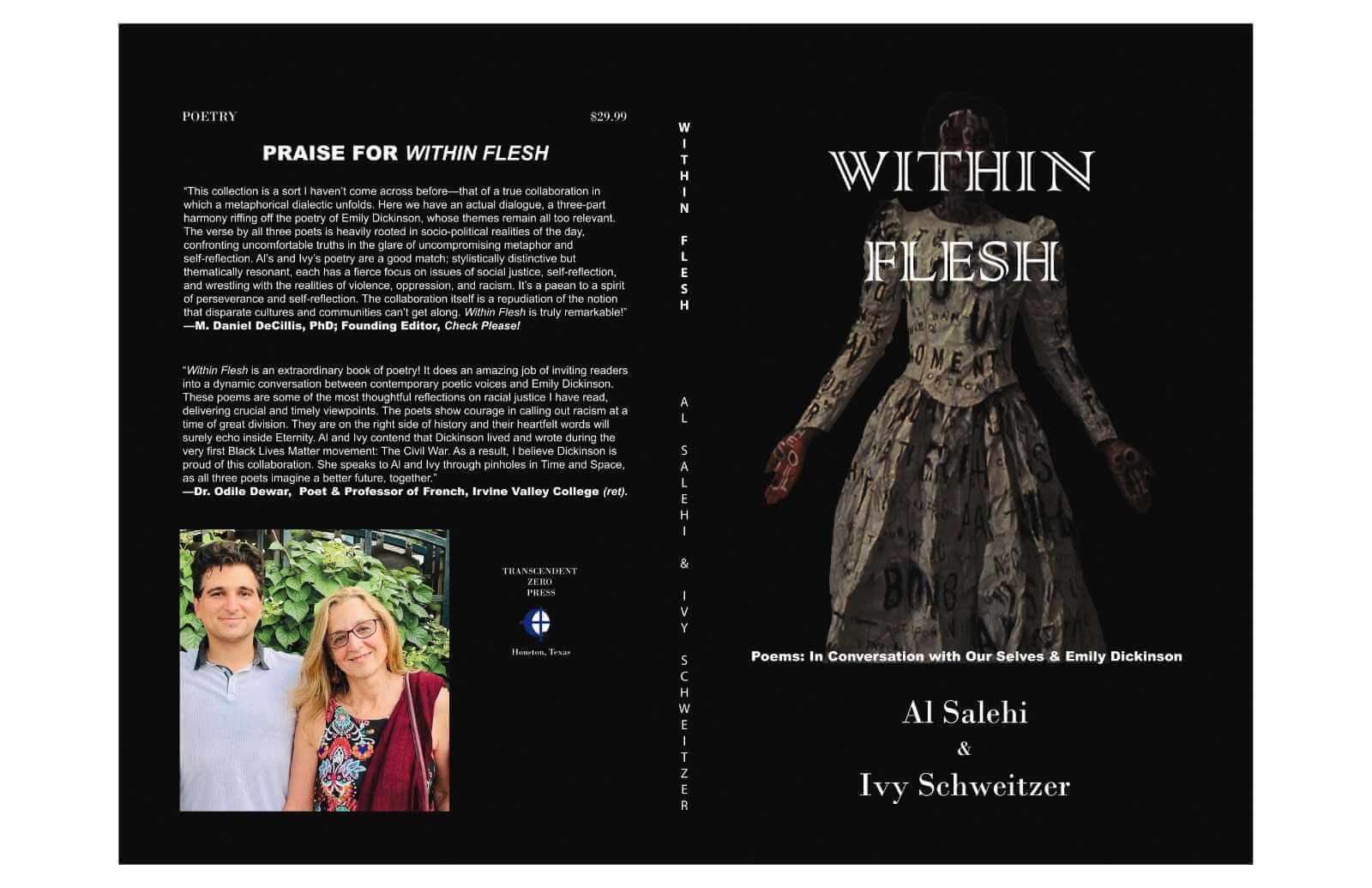Reading Time: 6 minutes
Dr Santosh reviews Al Salehi and Ivy Schweitzer’s “Within Flesh: A Collaborative Poem with Emily Dickinson,” exploring race, justice, and the human condition, exclusively for Different Truths.


To repair a broken world, the two writers, Al Salehi and Ivy Schweitzer, have resorted to the most powerful weapon in a writer’s armory: words. In this word war involving resistance, they have added one more voice, that of the literary icon, Emily Dickinson.
“How remarkably innovative”! were the first words that came to my lips on reading the book. Completely enchanted, I am so happy that I read this book, mainly because of two reasons.
Firstly, because I have been teaching Gandhi and Martin Luther King Jr. to MPhil students, and am a strong advocate of peace, nonviolence, justice, equality, and a robust belief in the fact that all lives matter!
Second, Emily is the inspiration for my most recent book of poetry. Dickinson.
As I went through the book, I was absolutely riveted…
As I went through the book, I was absolutely riveted, and could not stop myself from echoing the sentiments of the two writers, who say:
“We struggle to enact freedom, justice, and equality, which we so passionately advocate. And so, with this collection, we offer the reader our vision of a more colorful and just tomorrow.”
This amazing book, innovatively conceptualised, sprinkled with such words as prison, liberty, justice, injustice, rainbow, peace, humanity, inhumanity, dignity, and stark chasms, hammers at a person’s conscience. At a time when the world is torn apart by all sorts of negativities and divisiveness, it takes courage to talk about George Floyd, blatant racism, lynching, and hints at the doings of the Ku Klux Klan. [Hiding behind white hoods\While setting burning crosses\On neighbors’ lawns. Un-Hallowed Grounds—Al-[with Dickinson’s “Struck was I nor yet by lightning”]
Dickinson wrote during a time of great political division in US history, witnessing the Civil War. The two writers confess that as they wrote poem after poem inspired by her works, they experienced the feeling as if she were responding through time. “As in sleep – all Hue forgotten.”
In the introduction: “The Lamp Burns Sure Within” Emily Dickinson,] they say,
“At this moment in history, when nations choose to make war instead of pursuing peace with their neighbors of different backgrounds, we explore an alternative: the way of dialogue, creativity and imagining something better. We need examples of people working together, across cultural and political differences, even across the implacable abyss of time—which is what we have attempted in this collaborative collection of poems”.
Both writers mention that they challenged themselves to absorb and refract Dickinson’s ideas…
Both writers mention that they challenged themselves to absorb and refract Dickinson’s ideas, imagery, language and formal structures, oft echoing her poems and sometimes utilising the Senku, a form invented by Al. [It is a short form that merges two time-honored Japanese poetic forms, the Haiku and the Senryu, both three-line poems of seventeen syllables. The first references nature, and the second treats human nature in an ironic or satirical vein. The Senku takes up philosophical questions in a similarly concise manner, the first line stating a problem, expanded in the second line, and resolved—or not—in the last line.]
All Senkus in this collection is center aligned with each line capitalised.
To quote the writers again:
“We found this short form suited our frequently satirical viewpoints and ironic presentation of politics and human foibles and our striving for the compression and punchy tone Dickinson’s poems so often deliver.”
They also mention that they even came across many unintentional examples of Senku in Dickinson’s work, such as:
“I shall vote for Lands with Locks Granted I can Pick ‘Em (What we see / we know somewhat)
For their poetic conversations, the two have chosen Captivity and freedom, which figure in many of the Dickinson poems.
Each section in the book is titled with a resonant phrase from a Dickinson poem…
Each section in the book is titled with a resonant phrase from a Dickinson poem announcing its theme. The perennially fascinating Dickinson, [December 10, 1830 – May 15, 1886,] as we are well- aware of, had a voice with a haunting tenor, and a sparkling brilliance. Her poems epigrammatically compressed and enigmatically cloaked, left the readers to draw their own conclusions.
They have even included images of the manuscripts so one can read the poems as Dickinson wrote them. Her poems appear to be “radically open, improvisational and dynamic, making us all co-creators and editors of her poems.”
In the Foreword, Faleeha Hassan says, “the authors establish a profound connection between Dickinson’s poems and contemporary American issues. Exploring themes of race, identity and justice, they used passages from Dickinson work as entry points for their own poetry, building bridges between eras.” “Within Flesh challenges us, comforts us, and inspires us to dream of a better, more equitable world—one seemingly, within our reach.” In response to Dickinson’s In Search of Heaven on Earth — “Which is best? Heaven,” Al writes, “Researchers have found that at birth we see our world in black and white. And yet, a whispered dream echoes the promise of a Palace — where colors, unseen, escape Your imagination — to unpack through a prism, and un-filter through a kaleidoscope. Here, where peace flows, from Your breath to my pulse — I pray that You, God, are a dreamer, too.”
In response to Dickinson’s Over the Dichromatic Rainbow — “We shall find the cube of the rainbow.”
Al pens the following words:
“Human babies and dogs see dichromatically— certain colors only as divided parts of a particular shade. Might we someday grow to recognise every hue— tolerating then celebrating the full spectrum of our rainbow?
Ivy puts her thoughts in the following manner:
“Instead of drowning storm— God granted the rainbow rising from the muddy flood gracing the Ark’s prow. And in the midst of kneeling despair— King tendered the moral arc its circuit long and tortuous but, he promised, curved towards justice.”
Dickinson’s rhythmic structures and alliterative devices are so appealing …
Red Matters —with Dickinson’s “Under the Light, yet under”- Dickinson’s rhythmic structures and alliterative devices are so appealing, and this poem, deceptively marked by a sort of playful teasing, turns out to be metaphysical, subtly hinting at death.
Under the light, yet under, if I recall properly is almost reminiscent of the game we used to play as kids, where an object was hidden, and we were supposed to look for it. Hot – Hotter – The nearer one came to the treasure; the hotter one was supposed to be.
On this poem, Al and Ivy have the following takes:
‘Colored by melanin But brimming with blood — Our shades shouldn’t matter. Since we’re made from dust And filled with water — That’s the heart of our matter.’ —Al ‘Within flesh yet within Within the blood that boils Within arteries and art Within the bomber’s mind Closer than your tang in morning released from sleep Closer than skin scented with almonds Without I know what you are Without needing to know Without touch I cannot Without we dance before Closer than strangers in transit Closer than mystery bone Oh! for a fingertip spark leaping the Distance between we and everyone’ —Ivy
About Cancerous —with Dickinson’s “His heart was darker than the starless night”,
the two poets take the following stance:
Two groups — different colors inside: Smokers / Non-Smokers (Black / White). —Al In Fall 1965 Jesse and Burton appeared at Shellbank Junior High, sand-speckled hem of Brooklyn snazzy dressers but shy. My friend Candace said that someone said there were rat bites on their ears. They’re invading the school, my mother fumed. The schwartzes1.—a household word I’d heard all my life, means “black” in Yiddish, used casually for people they knew and even liked rolling off tongues in mouths that kissed me goodnight— Years later, trolling the library in search of books to diversify my teaching, I found an old bound volume Our Nig and gasped— —Ivy In Pillars of Salt, we get to read their takes on Dickinson’s “Color–caste–denomination” Al says “Regardless of: white-collar or blue-collar, entrepreneur or day laborer, sultan of the land or serf of the turf —1703 we all rebrand as salt of the Earth.” And Ivy says: “Salt of the earth salt of our tears, Some people breathe free others are pared down, Death may be democratic but life is not, We pass into air— leaving behind hardened bits: our griefs could not dissolve On Balloon Rising—with Dickinson’s “You've seen balloons set – haven’t you?” Al has the following to say, “Today, I am a servant for your birthday an ever-present present — a belonging.You tie a string around my neck, hold me down, bind me to 2.a chair, and make me entertain your kids. They take turns using me as a makeshift punching bag. And yet, by the Law of Conservation, my energy can never be crushed nor indentured. Inevitably, I shall slip through your fingers and rise above, constant over time — leaving all of you behind, bound to the earth, or — below it”. And Ivy asks, “Can we rise still grounded Tap earth, aspire sky. Can we set anchors?
“What do they offer as they ram knees to a throat? What can’t they grasp in the words, I can’t breathe?” p 56.
The last section, If vital Light, is all about dreams…
The last section, If vital Light, is all about dreams – dreams deferred, dreams exploding, , maddest dreams,
A united\ State [With Dickinson’s “Hope is a thing with Feathers”
Al’s poetic hope regarding this famous Dickinson poem is” “For the brilliant day, we choose to elevate together, it shall be as one bird of many colorful feathers.” And in the same vein Ivy says, “Windows flung open, doors refusing their jams, so we pass through, pass into each other, not passersby but passengers in flight, all colors abroad, abreast, unbranded, borderless.”
I have a confession to make.
I was not the same person after I had finished reading the book. Doubly enriched, I could now look at the world more critically.
This experiment of looking at contemporary issues, using the words of a nineteenth century poet, who, with her short, succinct lines could move, stir, and provoke, is indeed a commendable venture.
Let me echo the words of Candice Louisa Daquin, that they have ‘created a quiet masterpiece’. Its powerful impact suddenly sneaks up on you and you are overwhelmed.
Cover photo sourced by the author
















